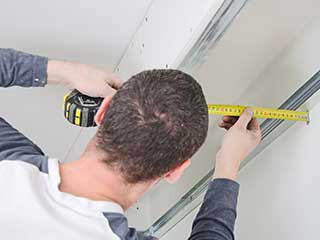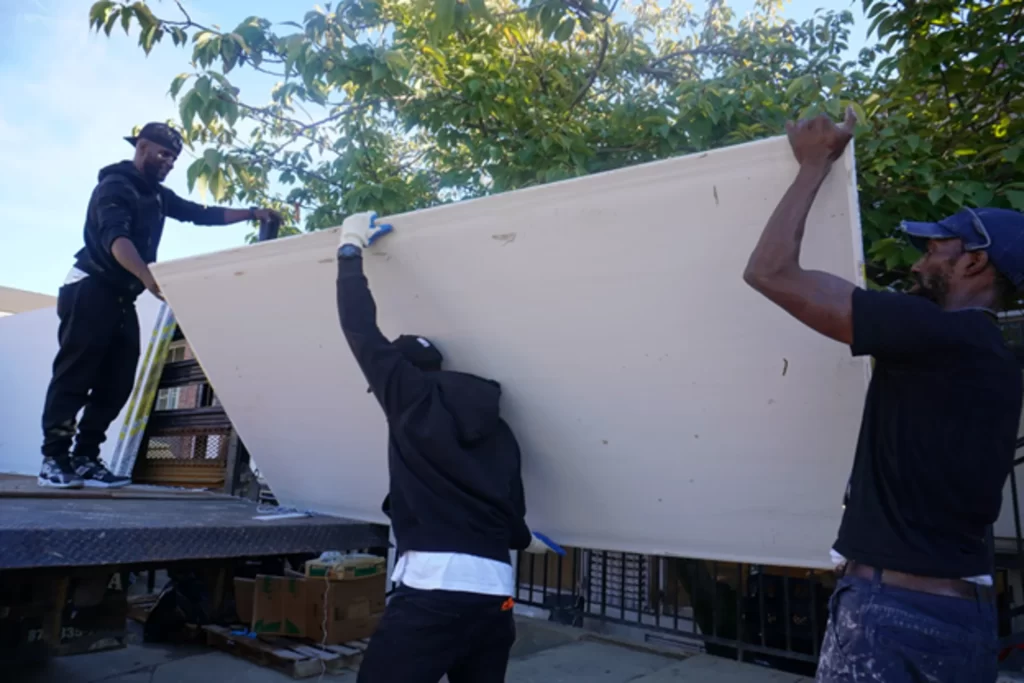Drywall contractors provide attention to detail that supports every Interior Painting project.
Step-by-Step Approaches to Getting Flawless Drywall Fixing and Installation
Achieving remarkable drywall repair and installation requires a methodical technique. It entails comprehending the various sorts of drywall and the tools needed for the job. Appropriate location preparation is vital prior to starting any kind of job. drywall contractors. Each action, from patching holes to mounting brand-new sheets, demands attention to detail. The process does not finish with installment; ending up methods are essential for a polished look. The following actions will assure a smooth outcome, yet what exactly do they require?
Understanding Drywall Types and Devices Needed

The setup devices are equally vital. An utility blade is important for reducing drywall sheets, while a drywall saw can help in making accurate cuts for fixtures or outlets. T-squares ensure precise dimensions, and drywall screws or nails safeguard the panels to wall surface studs. Additionally, a drywall lift can promote the installation of large sheets, reducing physical stress. Experience with these tools and types considerably adds to the effectiveness and quality of drywall jobs.
Preparing the Location for Repair Service or Installation
Preparing the area for drywall repair or installation is important to guarantee a smooth and effective process. First, the surrounding space ought to be free from furniture and other barriers to give enough functioning area. This not only ensures security however additionally avoids damage to personal belongings. Next off, it is essential to cover the floor with ground cloth to catch any kind of particles or dust produced during the job.
Additionally, the wall surfaces should be examined for any kind of loosened paint or wallpaper that may interfere with bond. Getting rid of these components creates a tidy surface for the brand-new drywall. Before beginning, it is advisable to shut off power to electric outlets or fixtures in the area. Making certain ample lighting in the workspace will certainly even more boost visibility and emphasis throughout the repair service or setup process. drywall contractors. By thoroughly preparing the location, one lays the groundwork for a successful drywall project
Step-by-Step Process for Patching Holes
:strip_icc()/how-to-patch-drywall-gray-wall-aadf75af0f5d4ec19704a770bd84efc2.jpg)
Patching holes in drywall calls for an organized strategy to guarantee a smooth repair work. The initial step entails evaluating the dimension of the hole. For small openings, a patching substance may be sufficient, while bigger openings require a patch. Next, the damaged area must be cleaned and prepared by eliminating any type of loosened particles.
For small holes, using spackling substance with a putty blade is advised, smoothing it over the opening and feathering the sides. When dry, sanding the location assures a smooth surface. For larger holes, a drywall patch should be reduced to dimension, placed over the hole, and secured with screws. After setting up the patch, the same spackling procedure is repeated, adhered to by fining sand.
The patched area must be topped and repainted to match the bordering wall. This precise process guarantees a professional look and expands the life expectancy of the repair service.
Setting Up New Drywall Sheets: A Comprehensive Guide
Setting up new drywall sheets calls for careful preparation and implementation to guarantee a visually attractive and strong surface. First, the location needs to be measured properly to determine the variety of sheets required. It is vital to select the right density, typically 1/2-inch for interior wall surfaces and 5/8-inch for ceilings or fire-rated applications.
Next, the studs or structure should be checked for any type of irregularities, making certain they are lined up and effectively spaced. When putting the drywall sheets, they need to be positioned flat to reduce joints and boost architectural honesty. A drywall lift can be helpful for overhanging setups.
Attaching the sheets with drywall screws at ideal intervals ensures a safe installment. It's important to countersink the screws somewhat below the surface area to plan for the ending up procedure. Following these guidelines will result in a solid foundation, ready for the following actions in drywall ending helpful site up.
Completing Touches: Taping, Mudding, and Sanding Techniques
Once the drywall sheets are securely attached, the focus changes to the finishing touches that click here to find out more will supply a sleek appearance. This process starts with taping, making use of either paper or fiberglass harmonize tape to cover the joints in between sheets. The tape assures a smooth change, reducing the risk of cracking. Adhering to insulation, mudding is vital; a joint substance is used over the tape to fill gaps and create a smooth surface area. Usually, several coats are required, every one feathery out additionally than the before decrease visibility.
After sufficient drying time, fining sand is the last action in attaining a remarkable coating. A fine-grit sandpaper is utilized to smooth the dried out substance, ensuring there are no bumps or blemishes. Focus to information throughout this phase is considerable, as it significantly influences the overall appearance of the wall. The end outcome ought to be an even, professional-looking surface area ready for priming and paint.
Frequently Asked Concerns
How Do I Select the Right Drywall Density for My Project?
To pick the best drywall density, think about the project's objective, place, and architectural demands. Standard densities include 1/2-inch for basic use and 5/8-inch for fire-rated applications, ensuring resilience and conformity with building ordinance.

Can I Mount Drywall Over Existing Drywall?
Yes, mounting drywall over existing drywall is feasible. It is essential to guarantee the underlying surface is secure and totally free from damages. Correct attachment and factor to consider of density are important for a successful installation.
What Are the Finest Practices for Drywall Disposal?
The finest techniques for drywall disposal consist of reusing when possible, utilizing regional waste administration services, and following standards for harmful materials if appropriate. drywall contractor. Correctly sealing and labeling waste guarantees compliance and safety during disposal
Just how Lengthy Should I Wait On Mud to Dry Before Sanding?
Usually, one must wait 1 day for drywall mud to completely dry prior to sanding. However, drying time can vary based on humidity and learn this here now temperature, so checking for a firm structure is recommended prior to proceeding.
Exist Eco-Friendly Drywall Options Available?
Yes, green drywall choices are readily available. These alternatives commonly utilize recycled materials, low-VOC adhesives, and lasting manufacturing methods, minimizing ecological impact while supplying reliable insulation and sturdiness for numerous construction and restoration tasks.
An utility knife is crucial for cutting drywall sheets, while a drywall saw can assist in making accurate cuts for outlets or components. Preparing the area for drywall repair or setup is crucial to ensure a efficient and smooth process. Covering openings in drywall requires a systematic technique to assure a seamless repair service. Installing new drywall sheets calls for careful preparation and implementation to assure a aesthetically appealing and tough coating. Yes, setting up drywall over existing drywall is possible.